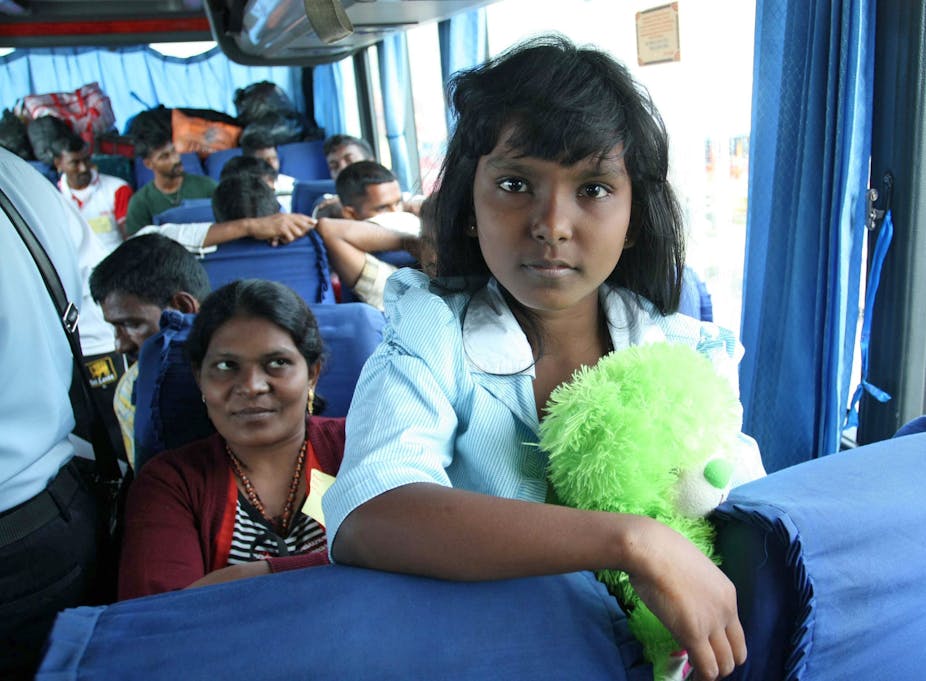Until recently most “boat people” seeking asylum in Australia have come from wartime situations or from dictatorships. But this is not the case for the increasing numbers coming from Sri Lanka.
Sri Lanka, a country of 20 million, has had democratic institutions and practices since 1931, when universal suffrage (including for women) was granted by the British. Sri Lanka was a poor country, but well-educated and with a range of social services and subsidies which reached the majority rural population. Power changed hands peacefully.
Today, there are many disturbing political issues which did not exist 40 years ago. These include the chaos and destruction caused by the long civil war between the Sri Lankan government and the Tamil Tigers.
This marked the end of the steady affirmation of power by the majority Sinhalese Buddhist population over the minority Tamil Hindu people of the north and east. After years of grievances expressed through democratic politics, tensions burst into open warfare in 1983.
Civil war: 1983-2009
For almost 30 years, Sri Lankans were at war with each other. Civil order collapsed in many regions and armed attacks were common even in the capital of Colombo. The Tamil Tigers controlled large areas of the north and east, had a uniformed army and a small navy, and collected considerable support from a growing number of Tamil expatriates in Canada, Britain and Australia.
Emigration increased for both Tamils and Sinhalese as civil society began to collapse. Assassinations of politicians became common, as did the informal arrest and murder of prominent critics of the government. An Indian peace-keeping force arrived, fought and departed, leaving much hostility behind. In an extremely bloody finale on the east coast early in 2009, the Sri Lanka army defeated the Tigers and killed its leader Prabhakaran. The massacre and subsequent internment of Tamil civilians has remained a controversial topic ever since.
The Western powers, including Australia, were only marginally concerned. Their focus was on Islam, which is only a minor religion in Sri Lanka. The Sri Lankan government was consolidated by Sinhalese politicians, drawn to a major extent from the Sri Lanka Freedom Party under a new name.
This party, led by the Bandaranaike family, had entrenched Buddhism and the Sinhala language. New leaders, Mahinda Rajapakse and his close relatives, now replaced the Bandaranaikes, supported by parties as varied as Buddhist monks and the former Marxist revolutionaries of the JVP. Those who had sympathised with the Tamil Tigers had no future. Rajapakse won a landslide election as president early in 2010. He consolidated his power with the arrest and imprisonment of his opponent, General Sarath Fonseka, who had led the war against the Tamils.
The case of the Tamils
The message of all this, at least to many Tamils, has been that relations between different communities were now over, and Sinhala Buddhism was triumphant. One of the strongest armies in Asia backs the victorious government. Despite efforts to clear internment camps, many thousand of Tamils had lost their homes and livelihood.
There was little apparent prospect for educated Tamils to enjoy the social positions which had previously been theirs. Sinhalese settlers were being given land in former Tamil areas. Sinhalese police and soldiers were stationed in Tamil towns and villages. The vision of a democratic multicultural society seemed dead. Disappearances and arrests continued, being directed especially against critics of the Rajapakses.
None of this is meant to excuse the vicious and authoritarian nature of the Tigers. They specialised in assassinating Tamil leaders who disagreed with them. They recruited child soldiers from the villages. Many Tamils accepted that this was inevitable in a national struggle, including asylum seekers who have since been subjected to ASIO clearance on information from the Sri Lanka government.
Sri Lankans know more about Australia than many other Asians. Many asylum seekers have already got relatives living in Australia. Sri Lankans in Australia are equally divided between Sinhalese and Tamils, with the Burgher communities now declining. And these immigrants and refugees are not only Tamils.
Most boats start out from the region around Negombo. This is known locally as the “little Rome” and is predominantly Catholic. Christians in a non-Christian society may feel insecure as a minority of Buddhists become increasingly militant.
Special measures
Sri Lankans keep coming. They know about Australia and its rich and empty land. They certainly know that civil society in Sri Lanka is no longer as safe, democratic and secure as it once was.
Tamils have more reason to come than others. Many are well educated, English speaking and capable of becoming good immigrants. Past generations of Sri Lankans have settled into Australia very well. The Tigers are discredited and there is little danger of militancy within Australia.
Nobody deserves to be locked away in Nauru. Facilities for granting visas in Colombo are limited and numbers allowed into the “queue”, such as it is, are very small. For these reasons, the government must set up an emergency quota for Sri Lankans seeking asylum in Australia.

